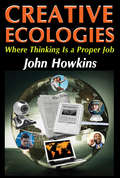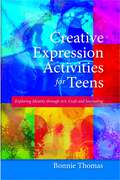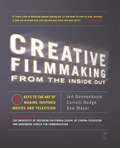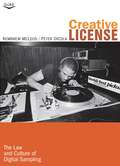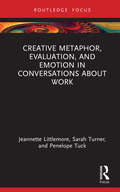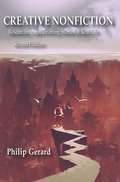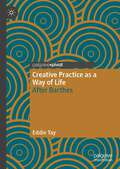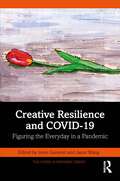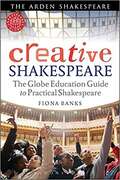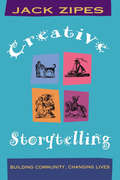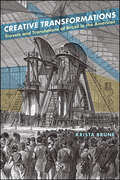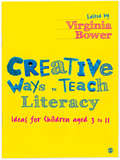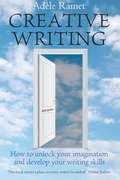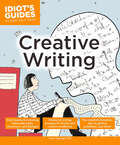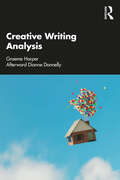- Table View
- List View
Creative Ecologies: Where Thinking Is a Proper Job (Creative Economy And Innovation Culture Se Ser.)
by John Howkins Bronislaw MalinowskiThe main question of our age is how we live our lives. As we struggle with this question, we face others. How do we handle ideas and knowledge, both our own and those of others? What relationship to ideas do we want? Whose ideas do we want to be surrounded by? Where do we want to think? Most choose, or have the choice made for them, according to what family, colleagues, and friends do and say and what we read about, and a more or less rational calculation of the odds.Modern ecology results from the shift in thinking generated by quantum physics and systems theory, from the old view based on reductionism, mechanics, and fixed quantities to a new view based on holistic systems where qualities are contingent on the observer and on each other. This perception changes how people treat ideas and facts, certainties and uncertainties, and affects both art and science. Worldwide it is part of the process of understanding the current crisis in the environment, and the balance of economy, creativity, and control required in our response.The book's starting point is the growing role that information has played in industrial economies since the 1800s and especially in the last thirty years. It is an attempt to identify ecology of thinking and learning. It is also based on the need to escape from old, industrial ways and become more attuned to how people actually borrow, develop, and share ideas. Throughout the book, Howkins asks questions and offers signposts. He gives no guarantee that creative ecologies will be sustainable, but shows what should be aimed for.
Creative Expression Activities for Teens
by Bonnie ThomasCoping with life's stresses is difficult for everybody, but can be especially challenging for teenagers, who often feel isolated and misunderstood. Creative expression through art, craft, and writing is a natural and effective way of helping young people to explore and communicate personal identity. This book is bursting with art and journal activities, creative challenges, and miniature projects for bedrooms and other personal spaces, all of which help teenagers to understand and express who they are and what is important to them. These fun ideas can be tailored to suit the individual, and require minimal equipment and even less artistic know-how, so can be enjoyed by all. The book concludes with a useful section for counselors and other professionals who work with young people, which explains how these activities can be incorporated into treatment goals. This imaginative and insightful book is a useful resource for all therapists, social workers, and counselors who wish to encourage self-expression in teenagers.
Creative Filmmaking from the Inside Out
by Jed Dannenbaum Carroll Hodge Doe MayerFive keys to creating authentic, distinctive work, whether you are a student, professional or simply love making films on your own For Creative Filmmaking from the Inside Out, three professors at the renowned University of Southern California School of Cinema-Television interviewed fifteen outstanding filmmakers, then distilled their insights into the "Five I's" of creativity. Learn how to: Uncover your unique creative voice (Introspection) Work from real-life observations and experience (Inquiry) Draw on your nonconscious wells of creativity (Intuition) Strengthen your creative collaborations (Interaction) Communicate at the deepest level with your audience (Impact) This comprehensive approach provides practical exercises that will enrich and transform your work, whether you are looking for a story idea, lighting a set, editing a scene or selecting a music cue. The participating filmmakers, who have collectively won or been nominated for 39 Oscars and 27 Emmys, are: Anthony Minghella, writer-director (The English Patient); Kimberly Peirce, writer-director (Boys Don't Cry); John Lasseter, writer-director-producer (Toy Story); John Wells, writer-producer (ER); Hanif Kureishi, writer (My Beautiful Laundrette); Pamela Douglas, writer (Between Mother and Daughter); Renee Tajima-PeÑa, director-producer (My America...or, Honk If You Love Buddha); Ismail Merchant, producer (The Remains of the Day); Jeannine Oppewall, production designer (L.A. Confidential); Conrad L. Hall, cinematographer (American Beauty); Kathy Baker, actor (Picket Fences); Walter Murch, sound designer-editor (Apocalypse Now); Lisa Fruchtman, editor (The Right Stuff); Kate Amend, editor (Into the Arms of Strangers); and James Newton Howard, composer (The Sixth Sense).
Creative Intuition in Art and Poetry (The A. W. Mellon Lectures in the Fine Arts #1)
by Jacques MaritainThe classic work on the sublime interplay between the arts and poeticsThis book explores the rich and complex relationship between art and poetry, shedding invaluable light on what makes each art form unique yet wholly interdependent. Jacques Maritain insists on the part played by the intellect as well as the imagination, showing how poetry has its source in the preconceptual activity of the rational mind. As Maritain argues, intellect is not merely logical and conceptual reason. Rather, it carries on an exceedingly more profound and obscure life, one that is revealed to us as we seek to penetrate the hidden recesses of poetic and artistic activity. Incisive and authoritative, this illuminating book is the product of a lifelong reflection on the meaning of artistic expression in all its varied forms.
Creative License: The Law and Culture of Digital Sampling
by Kembrew Mcleod Peter DicolaHow did the Depression-era folk-song collector Alan Lomax end up with a songwriting credit on Jay-Z's song "Takeover"? Why doesn't Clyde Stubblefield, the primary drummer on James Brown recordings from the late 1960s such as "Funky Drummer" and "Cold Sweat," get paid for other musicians' frequent use of the beats he performed on those songs? The music industry's approach to digital sampling--the act of incorporating snippets of existing recordings into new ones--holds the answers. Exploring the complexities and contradictions in how samples are licensed, Kembrew McLeod and Peter DiCola interviewed more than 100 musicians, managers, lawyers, industry professionals, journalists, and scholars. Based on those interviews, Creative License puts digital sampling into historical, cultural, and legal context. It describes hip-hop during its sample-heavy golden age in the 1980s and early 1990s, the lawsuits that shaped U. S. copyright law on sampling, and the labyrinthine licensing process that musicians must now navigate. The authors argue that the current system for licensing samples is inefficient and limits creativity. For instance, by estimating the present-day licensing fees for the Beastie Boys' Paul's Boutique (1989) and Public Enemy's Fear of a Black Planet (1990), two albums from hip-hop's golden age, the authors show that neither album could be released commercially today. Observing that the same dynamics that create problems for remixers now reverberate throughout all culture industries, the authors conclude by examining ideas for reform. Interviewees include David Byrne, Cee Lo Green, George Clinton, De La Soul, DJ Premier, DJ Qbert, Eclectic Method, El-P, Girl Talk, Matmos, Mix Master Mike, Negativland, Public Enemy, RZA, Clyde Stubblefield, T. S. Monk.
Creative Lives and Works: Frank Kermode, George Steiner, Gillian Beer and Christopher Ricks
by Alan MacfarlaneCreative Lives and Works: Frank Kermode, George Steiner, Gillian Beer and Christopher Ricks is a collection of interviews conducted by one of England’s leading social anthropologists and historians, Professor Alan Macfarlane. Filmed over a period of 40 years, the four conversations in this volume, are part of a larger set of interviews that cut across various disciplines, from the social sciences, the sciences and to even the performing and visual arts. The current volume on four of England’s foremost literary critics is the first in the series of several such books. Sir Frank Kermode, in James S. Shapiro’s (Professor of English and Comparative Literature at Columbia University who specializes in Shakespeare and the Early Modern period) words is, ‘the best living reader of Shakespeare anywhere, hands down’, George Steiner, in an article in The Guardian is described as a ‘polyglot and polymath’, Gillian Beer is quoted in The Guardian as saying, ‘I am historical remnant of free education: I was carried through by the state’, and W.H. Auden, one of the greatest 20th century poets, described Sir Christopher Ricks as ‘exactly the kind of critic every poet dreams of finding’. Immensely riveting as conversations, this collection takes one into the exciting world of literary criticism. The book will be of enormous value to those interested in Literature, History and Culture Studies. Please note: This title is co-published with Social Science Press, New Delhi. Taylor & Francis does not sell or distribute the Hardback in India, Pakistan, Nepal, Bhutan, Bangladesh and Sri Lanka.
Creative Metaphor, Evaluation, and Emotion in Conversations about Work (Routledge Focus on Applied Linguistics)
by Jeannette Littlemore Sarah Turner Penelope TuckThis book explores the roles played by creative and conventional metaphor in expressing positive and negative evaluation within a particular workplace, drawing on interviews with 31 current and former employees of the British Civil Service. Metaphor is often used to express evaluation but relatively few studies have investigated the ways in which metaphor is used to evaluate personal emotionally charged experiences. The volume explores how metaphor serves a predominantly evaluative function, with creatively used metaphors often more likely than conventional metaphors to perform an evaluative function, particularly when the evaluation is negative or ambiguous. The findings provide a deeper understanding of the relationship between evaluation, creativity, and metaphor. Examples, including military metaphors and family metaphors, show how creativity often comes through subverting the norms of use of a particular metaphor category, or altering the valence from its conventional use. The study elucidates the myriad ways in which people push at the boundaries of linguistic creativity in their efforts to describe the qualitative nature of their experiences. Demonstrating how metaphor can be a powerful tool for the nuanced expression of complex and ambiguous evaluation, this book will appeal to researchers interested in better understanding metaphor, creativity, evaluation, and workplace cultures.
Creative Nonfiction: Researching And Crafting Stories Of Real Life
by Philip GerardWriting creative nonfiction intertwines journalistic truth and literary techniques to tell a story that is clear, accurate, and exploding with meaning. Philip Gerard artfully guides readers through the entire creative nonfiction writing process, going beyond the technical basics to address topics such as ethics, voice, and structural integrity. In response to the genre's evolution, the latest edition includes examples to illustrate how cultural changes have influenced the way writers conduct research, approach writing, and communicate during the production of their projects. Timely, engaging, and poetic, Creative Nonfiction is the practical manual every novice and seasoned writer will want on their bookshelf.
Creative Nonfiction: The Final Issue: The Best of Thirty Years of Creative Nonfiction
by Lee Gutkind and Leslie RubinkowskiThe very best writing from one of America’s most groundbreaking literary magazines. When Creative Nonfiction debuted in 1994, the literary genre it championed was largely the target of skepticism or downright ridicule. But at a time when few editors were interested in the personal essay, the magazine doggedly explored new ideas and fresh modes of expression, and over the next three decades, its contributors pioneered what would come to be known as the “fourth genre.” The thirty-two essays collected here bring together some of the finest work Creative Nonfiction published over its seventy-eight issues. Read Pulitzer Prize-winner Charles Simic’s boyhood remembrances of the bombing of Belgrade, Carolyn Forche’s haunting, lyric catalog of her daily life as she faced down a cancer diagnosis, and John Edgar Wideman’s meditation on the photo of a murdered boy his same age—Emmett Till—and how the image haunted him forever. Here, you'll find work by such luminaries as Adrienne Rich and John McPhee, but also essays from more contemporary voices like Brian Broome, Elizabeth Fortescue, and Anne McGrath. With an introduction by Lee Gutkind, Creative Nonfiction’s founder and editor, this collection captures the evolution of a genre and the amazing work of the little magazine that helped make it all happen.
Creative Pasts: Historical Memory and Identity in Western India, 1700-1960 (Cultures of History)
by Prachi DeshpandeThe "Maratha period" of the seventeenth and eighteenth centuries, when an independent Maratha state successfully resisted the Mughals, is a defining era in the history of the region of Maharashtra in western India. In this book, Prachi Deshpande considers the importance of this period for a variety of political projects including anticolonial/Hindu nationalism and the non-Brahman movement, as well as popular debates throughout the nineteenth and twentieth centuries concerning the meaning of tradition, culture, and the experience of colonialism and modernity. Sampling from a rich body of literary and cultural sources, Deshpande highlights shifts in history writing in early modern and modern India and the deep connections between historical and literary narratives. She traces the reproduction of the Maratha period in various genres and public arenas, its incorporation into regional political symbolism, and its centrality to the making of a modern Marathi regional consciousness. She also shows how historical memory provided a space for Indians to negotiate among their national, religious, and regional identities, pointing to history's deeper potential in shaping politics within thoroughly diverse societies.A truly unique study, Creative Pasts examines the practices of historiography and popular memory within a particular colonial context, and illuminates the impact of colonialism on colonized societies and cultures. Furthermore, it shows how modern history and historical memory are jointly created through the interplay of cultural activities, power structures, and political rhetoric.
Creative Power: The Nature And Nurture Of Children's Writing
by Ronald L. CramerThis accessible book examines the nature of children's writing, and helps teachers discover how to best nurture in children's creative potential. A thorough explanation of the practices and strategies needed to understand young writers and their writing, the book provides a wealth of information and ideas about the language, interests, and creative capabilities of today's children. Strong pedagogy offers explicit, practical examples with direct application to instruction. Each chapter begins with a brief vignette that captures the drama and excitement of becoming a writer. Boxed features summarize the best approaches to putting instructional concepts and strategies into practice. For Elementary English Teachers.
Creative Practice as a Way of Life: After Barthes (Palgrave Studies in Creativity and Culture)
by Eddie TayThis book combines autoethnographic reflections, poetry, and photography with the aim to bridge the gap between creative practice and scholarly research. Drawing on an innovative combination of different forms of knowledge, creative writing and street photographs are presented as means to reflect on the development of knowledge and self-knowledge through a thought-provoking dialogue with Roland Barthes’ post-structuralist work. What does it mean to be a creative practitioner in a world traversed by values of capitalism and artificial intelligence? What does it mean to teach creative practices in such an environment?The urban landscape of Singapore, with the Jewel Changi mall, the Universal Studios, and Little India in the background, is the stage where the capitalist demands of modern city life grapple with the solitary act of writing poetry and taking photographs through the personal experience of the author. Capitalist realism and depression realism entwine with Barthes' notion of vita nova in a mesmerizing phantasmagoria that drags the reader to the bowels and secret pleasures of the creative process.
Creative Readings of Multilingual Picturebooks: International and Transdisciplinary Perspectives (Routledge Research in Literacy Education)
by Áine McGillicuddy Esa Christine HartmannThis edited volume offers fresh perspectives on linguistic and cultural diversity in multilingual picturebooks, examining their potential to support multilingual learning in different educational contexts. Drawing on international, transdisciplinary perspectives from over fifteen countries, the book provides a comprehensive view of this unique literary genre.The collection showcases a wide range of languages featured in multilingual picturebooks, including Chinese, Farsi, Georgian, Irish, Korean, Malagasy, Mexican Indigenous languages, Mirandese, Northern Sámi, Portuguese, Spanish, Te Reo Māori, Ukrainian, and Welsh. Various chapters examine how multilingual picturebooks foster language and literacy development for emergent bilinguals in multilingual and multicultural environments, highlighting benefits such as linguistic and semiotic code-switching, as well as their ability to stimulate intercultural awareness in readers. The book also considers the creation, translation, and complex publishing processes of multilingual picturebooks, while exploring modern technologies such as eye tracking to analyse the reading processes of these books.Reflecting current insights and innovations in picturebook research, this volume will appeal to scholars, academics, and researchers in language and literacy education, multilingual education, and early childhood education. Those involved in children’s literature studies, multimodality, and bilingualism more broadly will also find this collection valuable.
Creative Resilience and COVID-19: Figuring the Everyday in a Pandemic (The COVID-19 Pandemic Series)
by Irene GammelCreative Resilience and COVID-19 examines arts, culture, and everyday life as a way of navigating through and past COVID-19. Drawing together the voices of international experts and emerging scholars, this volume explores themes of creativity and resilience in relation to the crisis, trauma, cultural alterity, and social change wrought by the pandemic. The cultural, social, and political concerns that have arisen due to COVID-19 are inextricably intertwined with the ways the pandemic has been discussed, represented, and visualized in global media. The essays included in this volume are concerned with how artists, writers, and advocates uncover the hope, plasticity, and empowerment evident in periods of worldwide loss and struggle—factors which are critical to both overcoming the COVID-19 pandemic and fashioning the post-COVID-19 era. Elaborating on concepts of the everyday and the outbreak narrative, Creative Resilience and COVID-19 explores diverse themes including coping with the crisis through digital distractions, diary writing, and sounds; the unequal vulnerabilities of gender, ethnicity, and age; the role of visuality and creativity including comics and community theatre; and the hopeful vision for the future through urban placemaking, nighttime sociability, and cinema. The book fills an important scholarly gap, providing foundational knowledge from the frontlines of the COVID-19 pandemic through a consideration of the arts, humanities, and social sciences. In doing so, Creative Resilience and COVID-19 expands non-medical COVID-19 studies at the intersection of media and communication studies, cultural criticism, and the pandemic.
Creative Shakespeare: The Globe Education Guide to Practical Shakespeare
by Fiona BanksThis unique book desribes the ways in which educational practitioners at Shakespeare's Globe theatre bring Shakespeare to life for students of all ages.The Globe approach is always active and inclusive - each student finds their own way into Shakespeare - focusing on speaking, moving and performing rather than reading. <p><p>Drawing on her rich and varied experience as a teacher, Fiona Banks offers a range of examples and practical ideas teachers can take and adapt for their own lessons. The result is a stimulating and inspiring book for teachers of drama and English keen to enliven and enrich their students' experience of Shakespeare.
Creative Storytelling: Building Community/Changing Lives
by Jack ZipesJack Zipes has reinvigorated storytelling as a successful and engaging tool for teachers and professional storytellers. Encouraging storytellers, librarians, and schoolteachers to be active in this magical process, Zipes proposes an interactive storytelling that creates and strengthens a sense of community for students, teachers and parents while extolling storytelling as animation, subversion, and self-discovery.
Creative Transformations: Travels and Translations of Brazil in the Americas (SUNY series in Latin American and Iberian Thought and Culture)
by Krista BruneIn Creative Transformations, Krista Brune brings together Brazilian fiction, film, journalism, essays, and correspondence from the late nineteenth to the early twenty-first centuries. Drawing attention to the travels of Brazilian artists and intellectuals to the United States and other parts of the Americas, Brune argues that experiences of displacement have had a significant influence on their work. Across Brazilian literary and cultural history, translation becomes a way of navigating and representing the resulting encounters between languages, interactions with Spanish Americans, and negotiations of complex identities. While Creative Transformations engages extensively with theories of translation from different national and disciplinary contexts, it also constructs a vision of translation uniquely attuned to the place of Brazil in the Americas. Brune reveals the hemispheric underpinnings of works by renowned Brazilian writers such as Machado de Assis, Sousândrade, Mário de Andrade, Silviano Santiago, and Adriana Lisboa. In the process, she rethinks the dynamics between cosmopolitan and national desires and between center and periphery in global literary markets.
Creative Ways to Teach Literacy: Ideas for Children aged 3 to 11
by Virginia BowerShortlisted for the UKLA Academic Book Award 2013! Covering the essential areas of practice, this book suggests ways to make your literacy teaching as creative and engaging as possible. Children get the most out of their learning when it is exciting, and this book offers great ideas for classroom practice, whilst making careful links to research. Sections advise on teaching narrative, poetry and non-fiction, and each chapter contains case studies and ideas to try out in practice. The authors cover a broad range of topics, including: - exploring traditional tales - writing from experience - using playground games as a foundation for literacy - performing poetry. Written for teachers working with children aged 3-11 years, this book gives you the opportunity to develop children's literacy in enjoyable and interesting ways.
Creative Writer's Handbook (5th Edition)
by Philip K. Jason Allan B. LefcowitzThis handbook is the perfect reference for beginning creative writers. It offers abundant illustrations, exercises, and useful techniques in all genres. While emphasizing problem-solving and the mastery of literary conventions, this handbook also takes the apprentice writer on a journey from inspiration to revision.
Creative Writing
by Adèle RametThis book is a first-rate guide for writers who are looking for ways to improve their output. It focuses on: - Fiction writing and the world of genre fiction - science, romance, horror and crime. - Ways of drawing on personal experience in order to write non-fiction articles on a wide variety of topics in a number of different styles. - Writing for children which requires specialist skills that, once mastered, bring enormous satisfaction to both the writer and the reader. - The impact of the internet on the creative writer and the opportunities it presents. Crucially, there is also a chapter on presenting your work to a publisher and getting it into print.
Creative Writing
by Adèle RametThis book is a first-rate guide for writers who are looking for ways to improve their output. It focuses on: - Fiction writing and the world of genre fiction - science, romance, horror and crime. - Ways of drawing on personal experience in order to write non-fiction articles on a wide variety of topics in a number of different styles. - Writing for children which requires specialist skills that, once mastered, bring enormous satisfaction to both the writer and the reader. - The impact of the internet on the creative writer and the opportunities it presents. Crucially, there is also a chapter on presenting your work to a publisher and getting it into print.
Creative Writing
by Lavonne Mueller Jerry D. Reynolds'Creative Writing' takes writers through all the steps--from keeping a writer's journal to submitting manuscripts for publication. In an exciting format featuring numerous examples from student and professional writing, 'Creative Writing' presents techniques and tips for writing poetry, fiction, drama, and journalism.
Creative Writing (Idiot's Guides)
by Casey ClaboughCreative writing is arguably the ultimate form of self-expression. Ideal for anyone interested in writing (student or not), Idiot's Guides: Creative Writing helps readers master the basics of crafting compelling fiction and nonfiction stories. Various genres, including novels, short stories, plays and screenplays, poetry, book-length and article-length narrative nonfiction, memoirs, and more are covered. Content includes the fundamental elements, such as plot, character, point-of-view, setting, dialogue, style, and theme. And readers will be able to hone their writing skills and boost their creativity with writing prompts and exercises.
Creative Writing Analysis
by Graeme HarperCreative Writing Analysis is a guide to solving creative writing problems; acting as a practical introduction to progressing a creative writing project as well as an exploration of the many ways in which creative writing can be understood. Through chapters on topics including writing methods, textual analysis, practice-led research, interdisciplinarity, and cultural contexts, this book explores the various forms of analysis that can be employed. Graeme Harper provides information to assist in creative decision making, and as a means for discussing approaches and outcomes in creative writing. The book also includes an Afterword by Dianne Donnelly, whose work in Creative Writing Studies has been widely recognized as a contribution to the critical examination of creative writing. Whether you are a creative writer seeking to improve your work or you are simply interested in analysing the practice and outcomes of others doing creative writing, Creative Writing Analysis offers strategies to assist students and practitioners of creative writing and literary studies.
Creative Writing Exercises For Dummies
by Maggie HamandTurn your inspiration into a story with clear, expert guidance Creative Writing Exercises For Dummies is a step-by-step creative writing course designed to hone your craft, regardless of ability. Written by the founder of the Complete Creative Writing Course at London's Groucho Club, this activity-based guide walks you through the process of developing and writing in a wide range of genres including novels, short stories and creative nonfiction. The book includes writing prompts, exercises, mind maps, flow charts and diagrams designed to get your ideas flowing. You'll get expert guidance into character development, plot structure and prose, plus extensive insight into self-editing and polishing your work. Whether you're a new writer with a seed of an idea you would like to develop, or are looking to strengthen your creative writing skills, this book has you covered. Covering every aspect of narrative, from setting initial goals to formatting a manuscript, Creative Writing Exercises For Dummies provides the tools and instruction you need to make your story the best it can be. Learn to spark your imagination and sketch out ideas Create compelling characters and paint a picture with description Develop your plot and structure and maintain continuity Step back from your work and become your own ruthless editor The rise of e-books has opened up the publishing world, even to non-established writers. If you have a story you're dying to tell but aren't sure how, Creative Writing Exercises For Dummies is the clear, concise solution you need.
